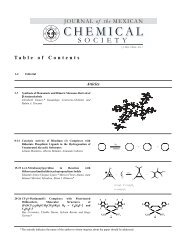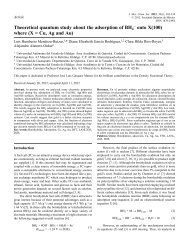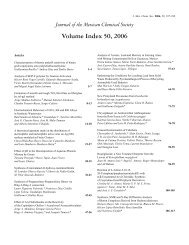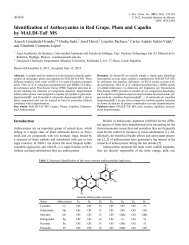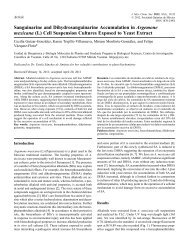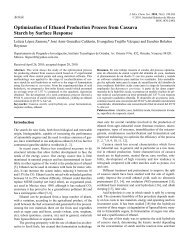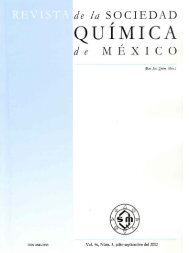SMQ-V043 N-001_ligas_size.pdf - Journal of the Mexican Chemical ...
SMQ-V043 N-001_ligas_size.pdf - Journal of the Mexican Chemical ...
SMQ-V043 N-001_ligas_size.pdf - Journal of the Mexican Chemical ...
Create successful ePaper yourself
Turn your PDF publications into a flip-book with our unique Google optimized e-Paper software.
State-<strong>of</strong>-<strong>the</strong>-art Protein Structural Biology 27<br />
amide I band and H D exchange studies revealed bands originating<br />
from polypeptide backbone conforination. The conclusions<br />
<strong>of</strong> FT-IR and laser Raman studies <strong>the</strong>refore were in concurrence.<br />
are progressing rnuch more rapidly. A set <strong>of</strong> proton-proton<br />
NOE contact distances were derived and used as an input in<br />
molecular dynamics simulation <strong>of</strong> amelogenin structure<br />
described below.<br />
7. 2D and 3D NMR Spectroscopic Studies<br />
<strong>of</strong> Bovine Amelogenin<br />
2D and 3D [1] H NMR [1] spectroscopy provides a blue print<br />
<strong>of</strong> <strong>the</strong> proton resonances and <strong>the</strong>ir spatial disposition through<br />
nuclear Overhauser enhancement (NOE) phenomenon which<br />
arises from spatial proximity <strong>of</strong> protons in a protein which<br />
give rise to a NOE cross-peak in 2D NOESY spectra, with an<br />
intensity proportional to <strong>the</strong> inverse sixth power <strong>of</strong> <strong>the</strong> distance<br />
between <strong>the</strong> two protons (l/r 6 ).Usually NOE’s are classified<br />
into strong, intermediate, and weak, which implies that<br />
<strong>the</strong> inter-proton distances are < 2.5 Å, < 3.5 Å, or < 5 Å. NOE<br />
data <strong>of</strong> bovine amelogenin is what led to <strong>the</strong> derivation <strong>of</strong> <strong>the</strong><br />
3D structure <strong>of</strong> bovine amelogenin. Recently 2D NMR studies<br />
<strong>of</strong> bovine amelogenin [l4] were focused on <strong>the</strong> elucidation <strong>of</strong><br />
amelogenin secondary structure in solution. The complex task<br />
<strong>of</strong> assigment <strong>of</strong> proton resonances using 2D COSY, selected<br />
NOE experiments, aided by automated assigment computer<br />
routines (FELIX, XEASY) has now been completed and will<br />
appear in <strong>the</strong> literature in 1999 [l4]. The hydrophobicity <strong>of</strong><br />
bovine amelogenin presents formidable challenge in 1D and<br />
2D NMR studies due to its poor solubility, whereas <strong>the</strong> 179-<br />
residue mouse amelogenin is more soluble in aqueous buffers<br />
and <strong>the</strong>refore 2D and 3D NMR studies <strong>of</strong> <strong>the</strong> mouse variant<br />
Fig. 3. Polypeptide Backbone Structure <strong>of</strong> <strong>the</strong> 170 residue bovine<br />
tooth amelogenin from NMR and Molecular Dynamics Simulations<br />
(Prabhakaran et al., 1991).<br />
8. Theoretical Derivation <strong>of</strong> <strong>the</strong> Secondary<br />
Structure <strong>of</strong> Bovine Amelogenin from 2D NMR<br />
Studies<br />
Recent advances have made it possible to explore <strong>the</strong> multidimensional<br />
energy surface <strong>of</strong> a protein by <strong>the</strong> calculation <strong>of</strong> <strong>the</strong><br />
elassical energy <strong>of</strong> a complex system like protein. The energy<br />
surfaces so obtained forrn <strong>the</strong> basis <strong>of</strong> molecular dynamics<br />
and Monte Carlo studies [15] Ano<strong>the</strong>r important method for<br />
exploring <strong>the</strong> energy surfaces is to find configurations for<br />
which <strong>the</strong> energy is a minimum at which point <strong>the</strong> molecular<br />
system is assumed to exist in a stable conformation. By<br />
adding external forces to <strong>the</strong> molecule in <strong>the</strong> form <strong>of</strong> restraints<br />
and constraints, a wide range <strong>of</strong> modeling strategies can be<br />
developed using minimization techniques as <strong>the</strong> foundation to<br />
answer specific questions. The pursuit <strong>of</strong> a global minumum<br />
for a protein is riddled with difficulties. Neverthless, <strong>the</strong> minimized<br />
structure provides complimentary information to physical<br />
methods in structural biology e.g. NMR. In Monte Carlo<br />
or Dynamic minimization, ensembles <strong>of</strong> structures can be generated<br />
to estimate <strong>the</strong>rmodynarnic averages. A sirnple but<br />
powerful restraint is to add a term restraining <strong>the</strong> distance<br />
between two atoms e.g. two protons, an estimate <strong>of</strong> which is<br />
obtainable from 2D NOESY experiments. Inclusion <strong>of</strong> NOE<br />
distance restraint with <strong>the</strong> energy function can yield a family<br />
<strong>of</strong> representative structures and constitutes a powerful method<br />
for solving structures <strong>of</strong> proteins in solution. Most application<br />
<strong>of</strong> NOE distance restraints to solving protein structures use<br />
ei<strong>the</strong>r distance geometry algorithms or molecular dynamics<br />
method. Minimization is resorted to only in <strong>the</strong> final stages <strong>of</strong><br />
<strong>the</strong> refinement <strong>of</strong> <strong>the</strong> 3D structure <strong>of</strong> a protein. Molecular<br />
dynamics method is linked to <strong>the</strong> solution <strong>of</strong> Newton equations<br />
<strong>of</strong> motion for all atoms in a protein, care should be exercised<br />
in establishing <strong>the</strong> initial conditions <strong>of</strong> <strong>the</strong>rmodynamic<br />
equilibrium. In such a process many conformations <strong>of</strong> a protein<br />
may be obtained wich are close in energy. To fur<strong>the</strong>r<br />
explore <strong>the</strong> fluctuations <strong>of</strong> such structures at any given temperature,<br />
it is required that <strong>the</strong> simulations should explore a<br />
time window <strong>of</strong> <strong>the</strong> order <strong>of</strong> several picoseconds. An alternative<br />
approach is a search for <strong>the</strong> global minimum in energy <strong>of</strong><br />
a protein. The search sometimes may end in a local minimum<br />
trap. A number <strong>of</strong> stochastic methods e.g. simulated annealing,<br />
threshold accepting, genetic algorithms TABU search<br />
[16] have been developed to circumvent <strong>the</strong> stalling <strong>of</strong> <strong>the</strong><br />
search for a global minimum in a local minimum trap. The<br />
application <strong>of</strong> <strong>the</strong> methods described here to amelogenin is<br />
described below.<br />
A combination <strong>of</strong> both approaches have been applied to<br />
amelogenin structure prediction. Amelogenin is a protein rich<br />
in β-sheet: β-turn segments [17]. Extensive protein secondary






